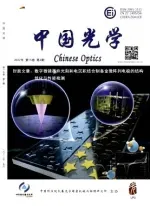Basic properties of trapezoidal channel plas mon polariton subwavelength waveguides
MA Jun-xian,FANG Yu,CHEN Bi-bo,TAN Rui-hu,LUO Xian-gang
(Advanced Technology Research Center,Shenzhen university,Shenzhen518060,China)
1 Introduction
The size of optical elements is close to the practical limit because of the diffraction effectof light.Asone of the promising ways to guide opticalwaves beyond the diffraction limit,low-dimensional optical waveguides have been receiving much attention in recent years[1].According to the definition of the dimension of optical waves[2],a Surface Plasmon Polariton(SPP)propagating along a planar metaldielectric interface is classified as a two-dimensional(2D)opticalwave.A typical 2D optical waveguide structure is a dielectric thin film sandwiched between the two semi-infinite metals.When the metal or dielectric film is thin enough,the SPPs generated on each metal-dielectric interface will couple,and turn into channel plas mon polaritons.
Asa departure from the rectangle CPP waveguides reported in recent years[3-6],a trapezoidal-shaped CPP waveguideis proposed as an elementary unit for use in integrated optical devices.The trans mission characteristics of this waveguide are studied and compared with those for rectangle CPP waveguidesusing FiniteDifference T ime Domain(FDTD)simulations.
2 Channel Plasmon Polaritons(CPPs)
The structure of typical 2D optical waveguide is shown in Fig.1. It is necessary to give a brief description of CPPs travelling in the sub-wavelength channel sandwiched be tween the two planar metal surfaces extended infinitely in they-axis direction.In this paper,only the T M mode consisting ofEx,Ez,andHycomponents is discussed.

Fig.1 Structure of the CPP waveguide,δ0=[Re(k)]-1andδm=[Re(p)]-1represents the penetration depth of SPP in the dielectric and metal,respectively.
Assuming the incident plane is thex-zplane,the T M waveHyfield component can be expressed asHy=yH0ei(k0z-w t),wherek0=2π /λ is wave number in vacuum. Omitting the time factor,the SPPs excited in the metal and dielectric can be expressed as

wherekandpare the wave numbers in the dielectric and metal,respectively,decide the penetration depth of SPPs(as shown in Fig.1,δ0=[Re(k)]-1andδm=[Re(p)]-1,βsppis the propagation constant of the coupled CPPs,A0,B0,C0andD0are the amplitudes of SPP transmission mode in dielectric and metal,andwis the width of the dielectric channel between the two semi-infinite metals.
According to the Maxwell equations and the continuity ofHyandEz,Eq.(1)can be derived:

By solving Eq.(2),the CPP dispersion equation can be expressed as follow:

where

hereε0andεmare the dielectric constants of the medium in the dielectric and metal,respectively.εmcan be calculated from the Drude for malismεm(ω)whereωpis the plas ma frequency,γ is the absorption andω(ω =ck0,cis the velocity of light in vacuum)is the frequency of the source,respectively.CPPs effective index can be given by


Fig.2 Dependence of complex propagation constant of CPPs in guide region(channel)on the channel width atwavelength of 650 nm.
When the channel width is very small,some guidingmodes can propagate in the air gap.In order to establish a quantitative understanding,Fig.2 presents the propagation constant Re[β](solid curve)and the loss Im[β](dashed curve)of the CPPs in guiding region for differentwidthsw,where ε0=1 for air andεmfor silver at 650 nm.The dotted curve corresponds to the propagation constant for the electromagnetic wave in vacuum. In narrow channels,both the real and imaginary parts of the CPPs propagation constant increase rapidly,implying the reduced propagation speed of CPPs as well as increased loss per unit length.
3 Simulation and results

Fig.3 (a)Forwin=30 nm,the relationship be tweenwoutand the transmitted power,(b)Forwout=30 nm,the relationship betweenwinand the trans mitted power(winandwoutindicate the widths of the input port and output port).
According to earlier researches,when the source of excitation is a 650 nm T M-polarized plane wave,the optimal length of the CPPs waveguide leading to maximum transmitted power is 150 nm[4].The same condition is chosen in our simulation.To determine how the structure will affect the transmitted power,the width of one end is fixed at 30 nm and the width of the other is varied.The s imulation result is shown in Fig.3,showing that the 30 nm/40 nm and 40 nm/30 nm(width of the input/output port)trapezoidal waveguide has more trans mitted power than the rectangular one.

Fig.4 Relationship between the length of trapezoidalshaped waveguide and the transmitted power when the wavelength of the light source is 650 nm.
To determine whether the channel shape will affect the opt imal length,the s imulation result in Fig.4 shows that the optimal length remains at 150 nm.
Based on the simulation result above,the trapezoidal-shaped CPPs waveguide is used as a basic element to constructeY-shaped and multi-Y-shaped coupler.The Poynting vectorSzcompared to the rectangle channel waveguide(w=30 nm)is shown in Fig.5. The trans mitted power of theY-shape and multi-Y-shaped couplers are higher than the traditionalones under the same input conditions.

Fig.5 Comparison of Poynting vectorsof theY-shaped,multi-Y-shaped couplers composed of trapezoidal and rectangularwaveguides.
4 Conclusions
W ith the progress of nano integration technology,the development of CPP waveguides in integrated optics becomes more and more important. This paper presentsa basic research on trapezoidal CPP waveguides and provides some reliable basis formore complex structures of CPP waveguides in future.Various types ofwaveguides consisting of trapezoidal CPPs and their construction scheme,which make the waveguide higher coupling efficiency and transmission efficiency,need more researches in the future.
Reference:
[1] TAKAHARA J,KOBAYASH I T.Low-d imensional optical waves and nano-optical circuits[J].Opt.Photonics News,2004,15:54-59.
[2] TAKAHARA J,YAMAGISH I S,TAKIH.Guiding of a one-dimensional optical beam with nanometer diameter[J].Opt.Lett.,1997,22(7):475-477.
[3] WANGB,WANG G P.Metal heterowaveguides for nanometric focusing of light[J].Appl.Phys.Lett.,2004,85(16):3599-3601.
[4] GAO H T,SH IH F,WANG CH T.Surface plas mon polariton propagation and combination in Y-shaped metallic channels[J].Opt.Express,2005,13(26):10795-10800.
[5] BOZHEVOLNYI S I,VOLKOV V S,DEVAUX E,et al..Channel plas mon-polariton guiding by subwavelength metal grooves[J].Phys.Rev.Lett.,2005,95(4):046802-046805.
[6] BOZHEVOLNYI S I,VOLKOV V S,DEVAUX E,et al..Channelplas mon subwavelengthwaveguide components including interferometers and ring resonators[J].Nature,2006,440:508-511.
- 中國光學(xué)的其它文章
- I nvestigation on spontaneously generated coherence
- All-fibre flat-top comb filter based on high-birefringence photonic crystal fibre loop m irror
- Multiple 3D optical trapp ing using higher polarization order axially-symmetric polarized beams
- Tailoring the properties of opticalmetamaterials
- Negative permeability in planar metal-dielectric composites
- Strong dual band metamater ial absorber in terahertz regime

